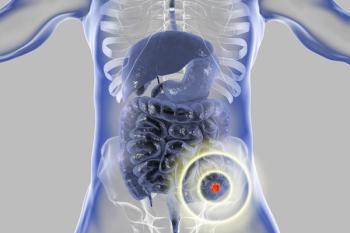
Muscle Loss Associated With Worse Survival in Metastatic CRC
Muscle area decreases significantly during treatment for metastatic colorectal cancer, and lower muscle area is associated with poor survival.
Muscle area decreases significantly during treatment for metastatic colorectal cancer (CRC), and lower muscle area is associated with poor survival, according to a new study.
“Low muscle mass is present in approximately 40% of patients, and not only in those who are underweight,” wrote study authors led by Henk M. W. Verheul, MD, PhD, of VU University Medical Center in Amsterdam. Previous work in pancreatic and other cancers showed that sarcopenic obesity-low muscle mass in combination with high body mass index-is a prognostic indicator of poor outcome.
In the new study, researchers examined change in skeletal muscle in 67 patients with metastatic CRC. Skeletal muscle area was assessed using CT scans of the third lumbar vertebra before and during palliative chemotherapy. The results were
The patients were mostly male (63%) and had a mean age of 66.4 years; most patients (82%) had multi-organ metastases. In the full group, skeletal muscle area decreased by 6.1% over 3 months (P < .001); in men, this meant a drop of 1.7 kg, and in women the drop was 1.1 kg. Body weight decreased significantly in women (4.4%; P = .031) but not in men.
The median overall survival in patients receiving first-line chemotherapy was 17.5 months, and 8.5 months in those receiving second-line or beyond chemotherapy. Patients with muscle loss of at least 9% during treatment had a survival rate at 6 months of 33%, compared with the lower two tertiles of muscle loss (less than 9% loss) at 69%. At 1 year, these rates were 17% in the greater muscle loss tertile and 49% in the lower muscle loss tertiles (P = .001).
After adjustment for sex, age, baseline LDH concentration, comorbidity, single organ or multiple organ metastases, treatment line, and tumor progression at first CT evaluation, this relationship remained significant. The hazard ratio for shorter survival in the highest muscle loss tertile was 4.47 (95% CI, 2.21–9.05; P < .01).
The authors noted that future studies of treatments in this malignancy could recruit patients “beyond those with severe weight loss or cachexia,” since muscle loss appears to be a predictor of outcome. “Alternatively, causes of muscle loss could be studied more in depth to find rational intervention possibilities,” they wrote, adding that it should be investigated whether interventions might attenuate or improve muscle mass during metastatic CRC treatments and if that could improve survival outcomes.
Newsletter
Stay up to date on recent advances in the multidisciplinary approach to cancer.



















































































